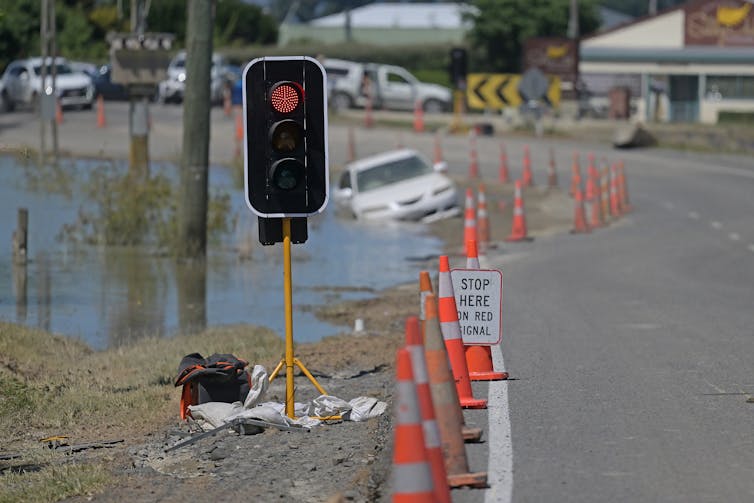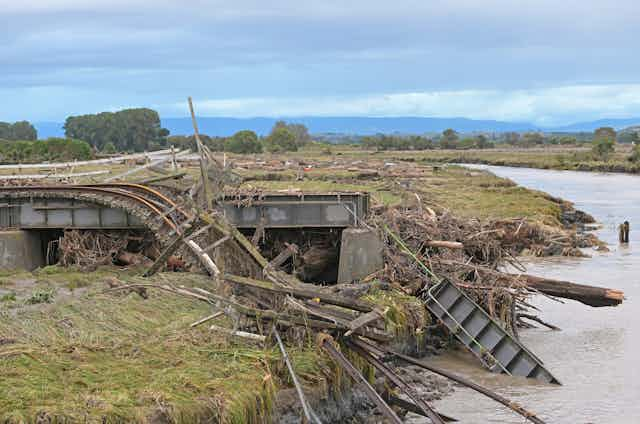Cyclone Gabrielle caused chaos one year ago. Repairs due to that storm and the Auckland floods have required substantial time and resources. Hawkes Bay, parts of Auckland and the Coromandel all still bear the scars of the worst storm to hit New Zealand this century.
The good news is that most initial repairs are complete. The bad news is that the restored infrastructure is just as vulnerable as it was prior to Gabrielle. Restoring infrastructure to the way it was before a natural disaster is not necessarily the best approach for a resilient future.
Cyclone Gabrielle simultaneously exposed New Zealand’s dependence on “horizontal” infrastructure (electricity and roading networks, for example), and how tenuous and potentially prone to damage it is.
The cyclone also revealed the flaws in the country’s planning and consenting processes. There is a history of developing new housing in flood-prone areas – particularly in Auckland. A year after Gabrielle, New Zealand needs to look to the future of climate risk, policy creation and infrastructural investment.
Both the previous and current governments have expressed concerns over future climate impacts. Yet climate risk and related infrastructure investment were comparatively minor themes in the various election debates of 2023.
New Zealand now needs to ask some serious long-term questions:
How frequently will it be exposed to the costs and chaos of weather events?
How should it respond to those risks?
What are the infrastructural investment priorities?
How should it sequence its responses?
And how will we pay for these measures?
Political agreement in theory
Failing to ask – let alone answer – those questions means New Zealand can’t plan, can’t build and can’t budget.
In October 2016, the National-led government’s environment minister Paula Bennett announced the ratification of the Paris Climate Accord. The treaty became legally enforceable in New Zealand in 2020 while Jacinda Ardern was prime minister.
Fundamentally, the commitment to addressing climate change is a point of agreement across the political spectrum.
Having ratified the Paris Accord, cuts to the country’s emissions are legally enforceable and time-bound. But New Zealand’s infrastructural planning, investments and commitments remain vague.
Read more: Massive outages caused by Cyclone Gabrielle strengthen the case for burying power lines
The Ardern government produced “Adapt and Thrive: Building a climate-resilient Aotearoa New Zealand” in August 2022. There was little coverage of this consultation document at the time or since, and the general public is largely unaware of it.
Adapt and Thrive advocates multiple strategies in response to climate change, including “avoid, protect, accommodate, retreat”. All elements of this plan have planning, legislative and resource implications.
But central to the report is the idea of “managed retreat” from flood-prone areas. The report indicates 300,000 dwellings will be directly affected by adverse weather events in the future. At least NZ$100 billion worth of property has been flagged as directly at risk, affecting 72,000 New Zealanders.
It is fair to say that the cost of new housing and infrastructure designed to protect at-risk communities, as well as service relocated ones, will be spectacularly expensive.

Can NZ ‘adapt and thrive’?
It is now time for New Zealand to decide to what degree it wishes to ameliorate the effects of climate change.
If this is a national priority, then planning, budgeting and sequencing need to be committed to. Hundreds of billions of dollars will be needed over a multi-decade, integrated programme of planning, compulsory purchase and infrastructure construction.
With the change of government, however, will that plan be put into action? There are aspects of it that make this questionable.
The different treatment of stakeholder groups around compensation during “managed retreat” will be problematic for the new governing coalition.
For example, Adapt and Thrive proposes 50% compensation for businesses and rental property owners, with zero compensation for bach or second home owners. Relocated communities’ resilience in terms of jobs, economic activity and housing will become contentious.
Adapt and Thrive also proposes limiting of rights of appeal for affected communities. The extensive planning and procurement processes involved make it hard to imagine the right to appeal being entirely quashed. Inevitably, the process of planning, financial commitments and appeals will be drawn out.
Read more: NZ cities urgently need to become 'spongier' – but system change will be expensive
Time for big decisions
To say Adapt and Thrive will be challenging to put into effect is an understatement. If the policy is going to be reconsidered, so be it.
But New Zealand has pressing infrastructural investment needs to facilitate growth and sustainability. The planning and procurement needed to implement such policy is time-consuming and costly. Irrespective of political orientation, there is an absolute need to prioritise it.
Given the huge financial consequences, and inevitable trade-offs in social programmes, education, defence and other budget priorities, a time frame for making big decisions is essential.
Failure to do so will inhibit future growth and housing provision, reduce cost-effectiveness, as well as threaten the sustainability of communities in vulnerable areas. Cyclone Gabrielle made it clear that kicking this particular can down the road is not acceptable.

